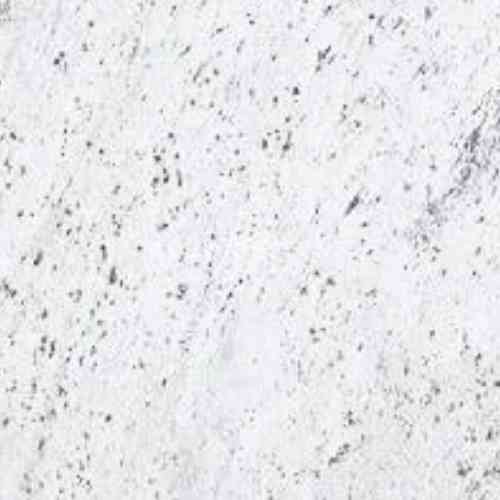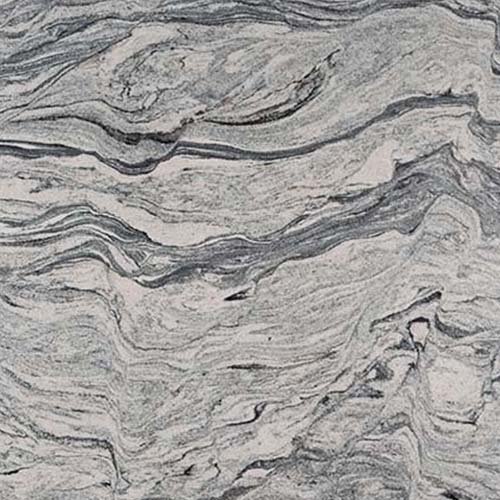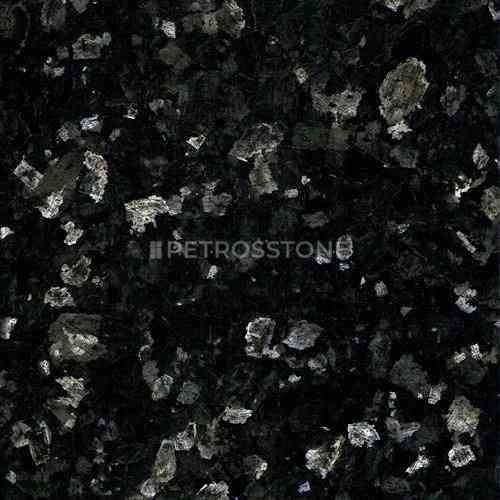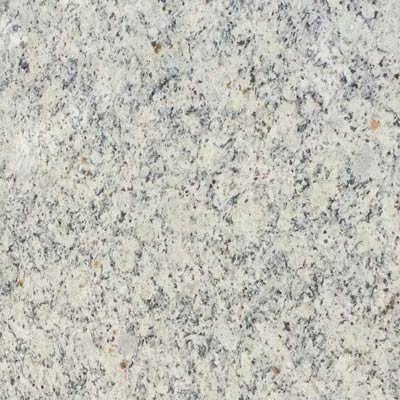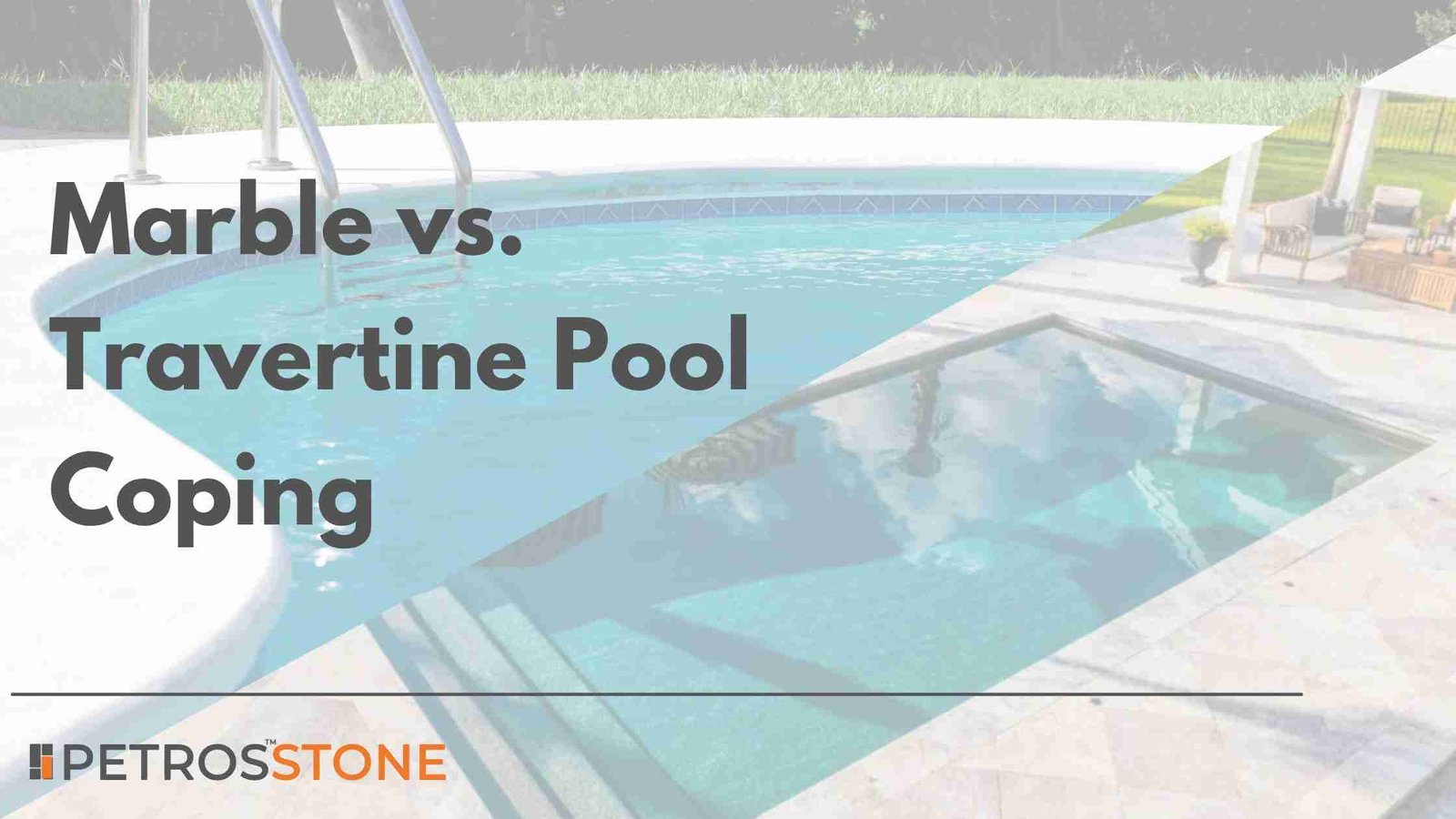
Marble and Travertine are one of the most popular luxury pool coping and decking materials. In this article we will look at the pros and cons of each and help you decide which one to use for your project.
Pool coping is the material into which a pool is finished on the edge or border; as such, it is where the shell of the pool meets the deck surrounding the pool. It has functional and decorative purposes. Functionally, coping seals the sides of the pool against infiltration of water and erosion, diverts water flow away from the pool shell wall and conceals the edge of the pool shell.
Proper coping material will be safe, comfortable, long-lasting, and visually consistent. It is the final finishing that can enhance the style of a pool and enhance landscape additions, such as water enjoyment and outdoor lifestyle facilities.
- Importance of Choosing the Right Coping Material
- Pool Coping Cost Comparison
- Pros and Cons of Marble Pool Coping
- Pros and Cons of Travertine Pool Coping
- Finish Options and Slip Resistance
- Water Absorption Comparison
- Heat Absorption on Sunny Days
- Design Ideas and Aesthetic Appeal
- Which One Is Better for Your Pool?
- Conclusion
Importance of Choosing the Right Coping Material
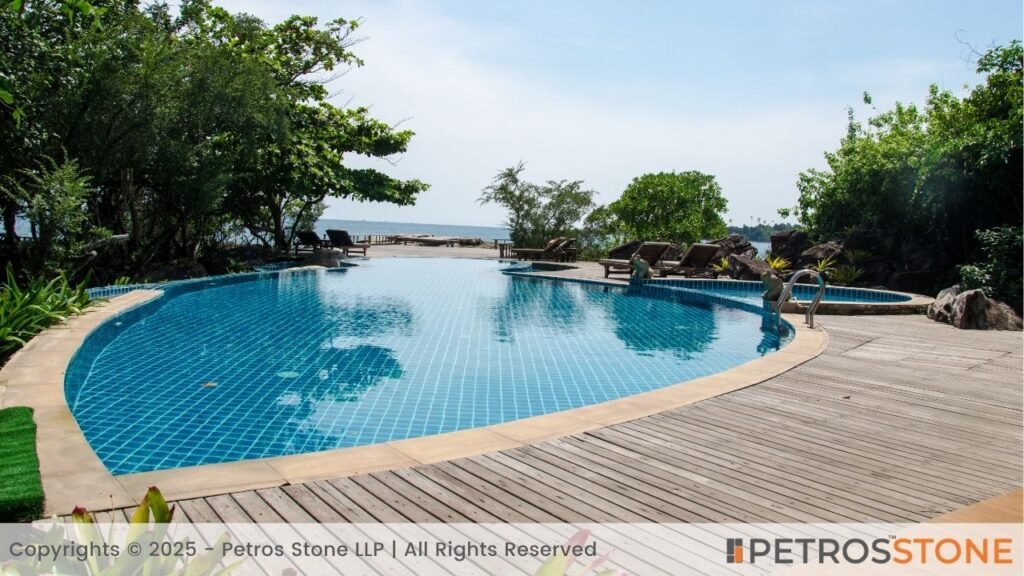
It is essential that the appropriate coping material is chosen due to numerous reasons:
- Safety: Gives grip and smooth edges to avoid slips and injuries.
- Structural protection: Causes water to go around and protects the pool shell against damage.
- Heat control: Affects the amount of heat in direct sunlight.
- Aesthetic harmony: It matches the design, deck and landscaping of the pool.
- Maintenance: Affects cleaning needs, the frequency with which it needs to be sealed, and how long it can last.
Pool Coping Cost Comparison
Initial Cost Overview of Marble and Travertine

The in-built cost comprises material cost, shipping, cutting, and installation. Depending on origin, grade, finishing, and local supply chains, costs may differ significantly.
| Material | Cost per sq ft (materials) | Installed Cost Range |
| Marble | $15 – $40 | $20 – $50 per sq ft |
| Travertine | $8 – $20 | $10 – $25 per sq ft |
- Marble: Commonly from Italy, Greece, or Turkey. The dramatic veining in premium grades is less common and drives the prices up.
- Travertine: Quarried in Canada, Turkey, Peru, Iran, etc. The more popular grades are more abundant; superior (“high-end”) cuts fetch higher prices.
To know the exact cost for your preferred natural stone coping, chat with us or check out this free online pool coping cost calculator
Installation and Maintenance Costs
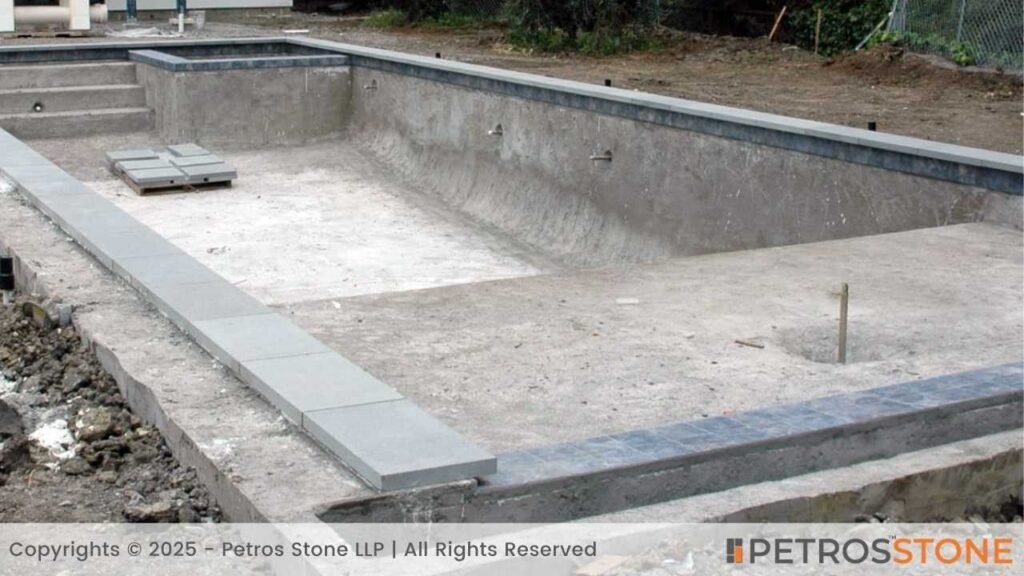
1. Marble
- Needs accurate cutting, particularly bullnose or personalised edge shapes.
- Raised surfaces must be provided with edging and anti-slip treatments.
- Sealed with a sealer and then re-sealed every 1-2 years.
- Stone cleaners should be pH neutral; acidic stone cleaners may etch marble.
2. Travertine
- A little easier to cut and carve.
- Naturally slip-resistant are textured finishes (tumbled, brushed). They have no extra treatments.
- Should be sealed against natural porousness; re‑seal every 1-3 years.
- Simple water and plain soap are generally adequate to clean.
Long-Term Value
1. Marble
- High profiles can raise the value of the property.
- Has a life of 20-40 years with proper maintenance.
- Expenses are extended to anti-slip coating and sealing.
2. Travertine
- Sturdy strength; tough texture conceals wear on the surface.
- When pits are treated and sealed, up to 20-30 years.
- Reduced recurring costs–in many cases, a cheaper long-term option.
| Category | Marble | Travertine |
| Initial cost | High | Moderate |
| Maintenance cost | Moderate-High (seal+clean) | Moderate |
| Lifespan | 20–40 years (with care) | 20–30 years |
| Resale impact | High-end, luxurious appeal | Timeless, but less premium |
Pros and Cons of Marble Pool Coping
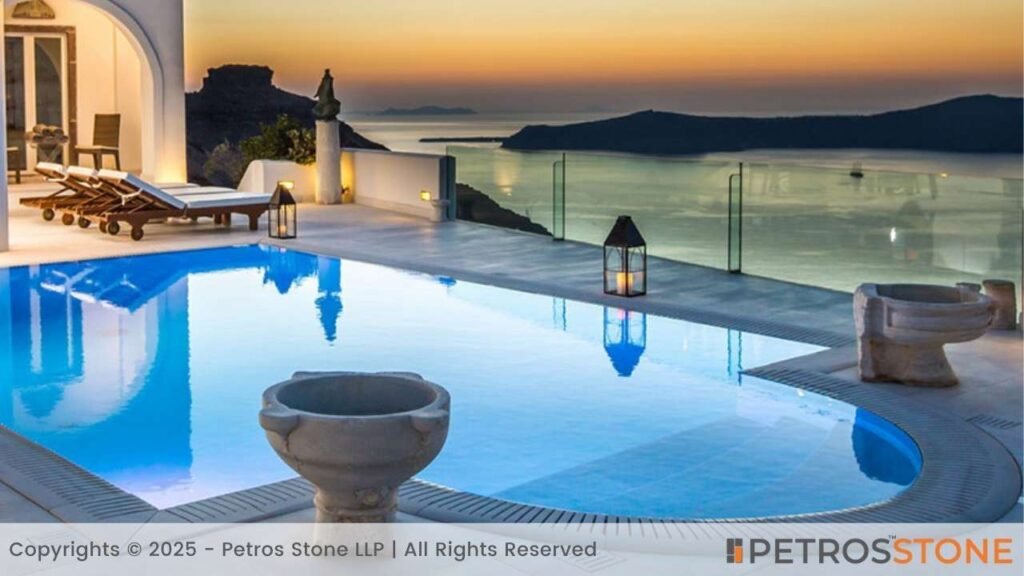
Pros of Marble
- Luxurious and elegant: Sophisticated, polished surface gives a high-end, fancy-looking appearance.
- Cool underfoot: Admirably reflects the heat, and in hot weather will be easy on the underfoot.
- Modifiable: The ability to bend into curved edges or custom shapes.
- Wearable when sealed: Water and stain-resistant.
- High property value: Increases the aesthetics and selling price of the land.
Cons of Marble
- Expensive: High-quality materials and expert installation are very costly.
- Slippery: A wet, polished finish may be dangerous.
- Stain prone: Discolours easily with oils and pool chemicals.
- Acid sensitive: Acidic media may leave monotone spots or disconcertion.
- Cold edges: Walking on it makes the feet feel cold during the winter months.
- Maintenance: Requires periodic sealing, anti-slip, and sometimes.
Pros and Cons of Travertine Pool Coping
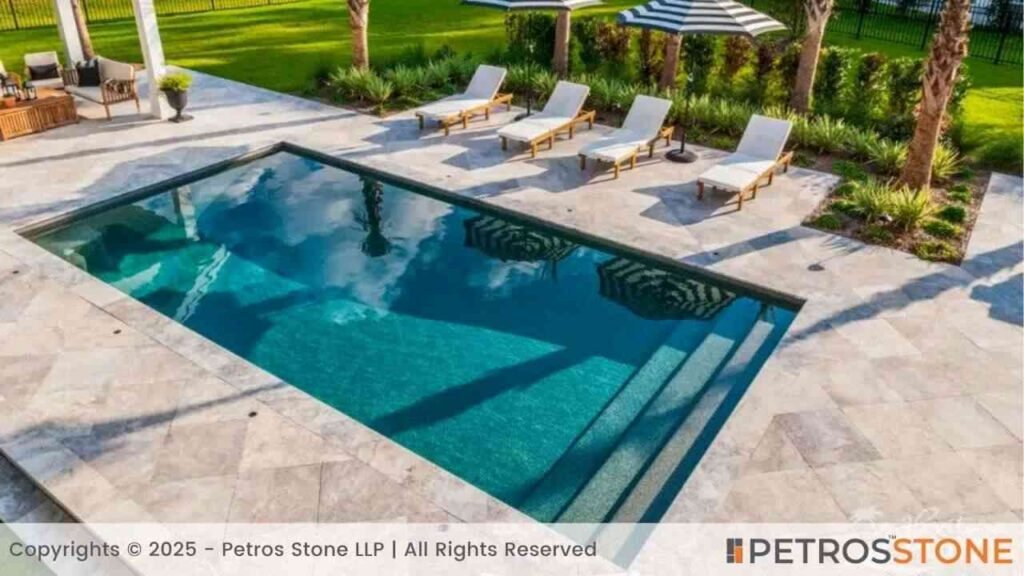
Pros of Travertine
- Good traction: Excellent wet grip given by naturally textured surface.
- Keeps cool: Reflects heat, thus comfortable to walk bare feet in hot weather.
- Affordable: Premium is relatively affordable compared to marble in terms of both materials and installation.
- Rustic beauty: Natural or traditional fits earthy tones.
- Heritage appeal: Fits Mediterranean, Tuscan or resort-designed pools.
- Texture hides wear: Little chips or stains smooth into the natural appearance as time goes by.
Cons of Travertine
- Natural Pits: open holes create pits that may trap dirt or algae.
- Porous structure: Absorbs moisture and chemicals- must be sealed.
- Edging problems: Will chip more easily unless carefully installed.
- Durability of colour: Can turn darker or lighter; not all people like the worn-out look.
- Heavy tiles: It is heavier than certain materials, and this can increase installation effort and cost.
Finish Options and Slip Resistance
Popular Finishes for Marble
1. Polished
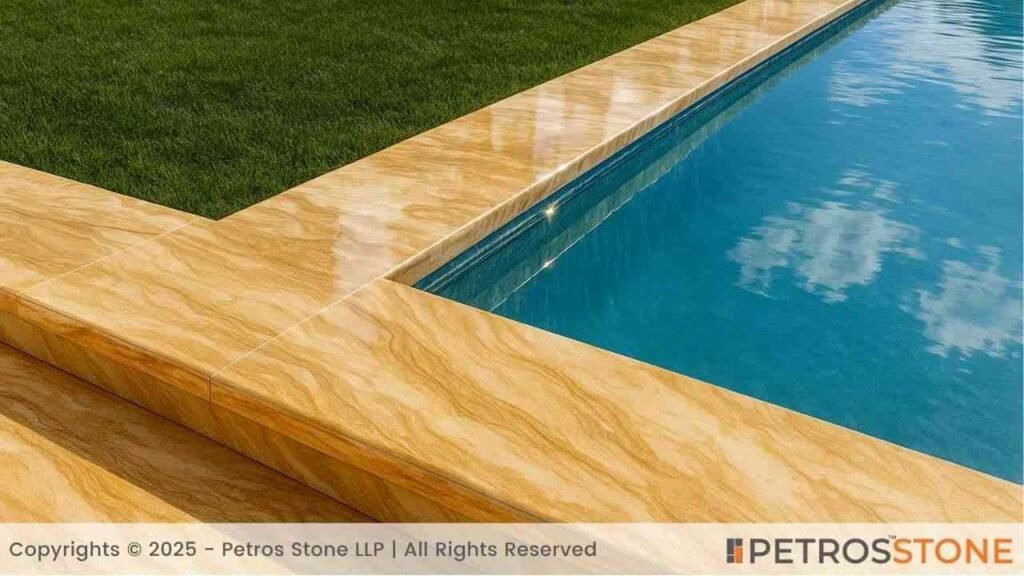
- Appearance: Its surface is glossy and reflects a lot of veining.
- Texture: smooth, not grippy at all.
- Best used on: luxury pools, modern.
- Warning: Skid: In wet conditions, requires non-slip treatment.
2. Honed
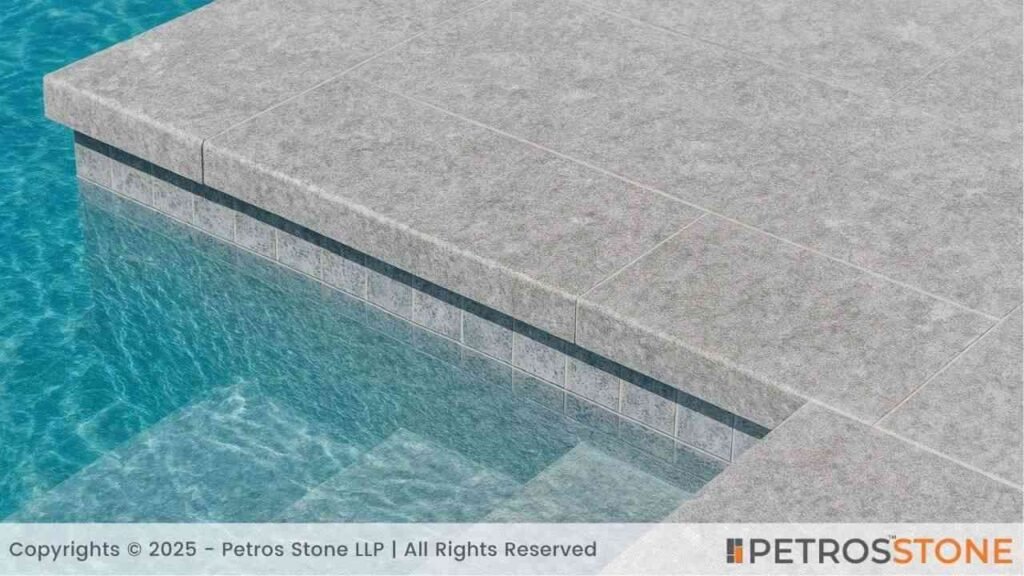
- Appearance: It has a matte-satin finish.
- Texture: Slightly textured; Not as dangerous as polished.
- Most Attuned: Classy swimming pools that require improved traction.
- Maintenance: Hides away water spots and etching.
3. Tumbled
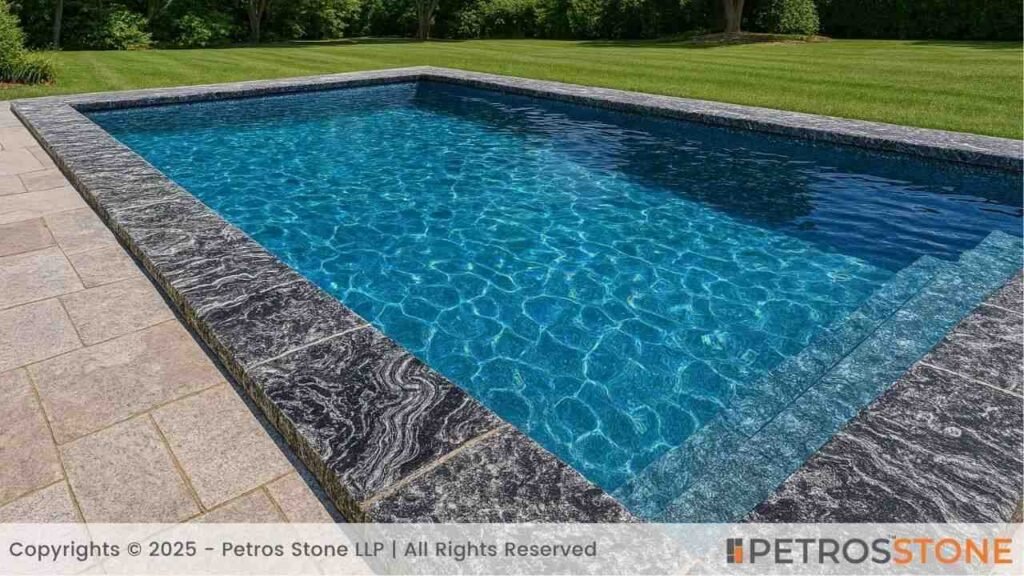
- Look: Old/worn-down look; rounded edges.
- Texture: This is naturally rough and grippy.
- Best Suited: Natural or Mediterranean-type pools.
- Safe: Provides superb footgrip.
4. Slip Resistance Rating (Out of 2)
| Finish | Texture Level | Slip Resistance (0–2) | Comments |
| Polished | Very Smooth | 0.5 | Slippery; needs treatment |
| Honed | Softly Textured | 1.2 | Moderately safe |
| Tumbled | Rough/Textured | 1.8 | Safest for pool surroundings |
Popular Finishes for Travertine
1. Brushed
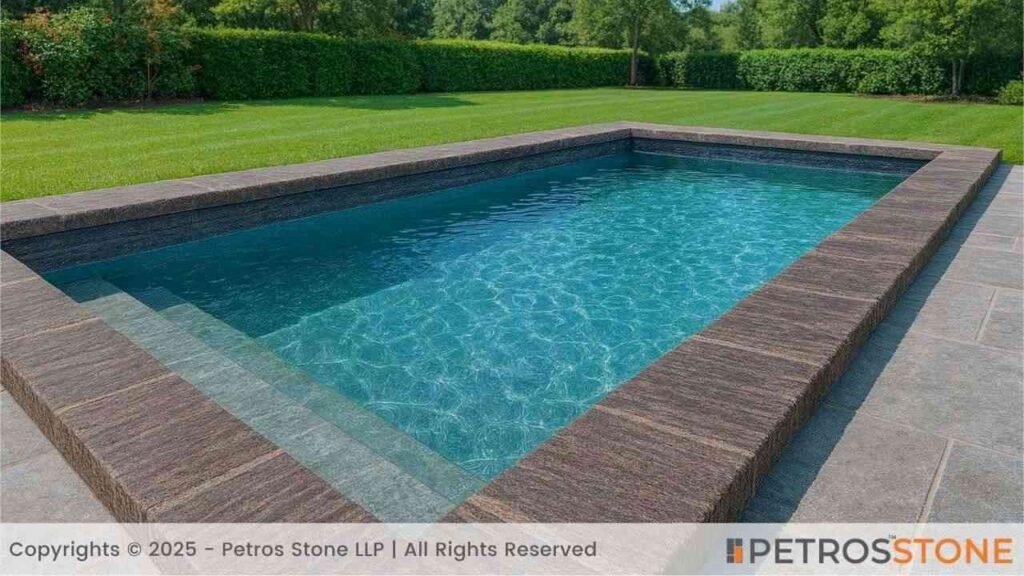
- Appearance: Soft, worn look with muted tones.
- Texture: Brushed lightly, rough.
- Best Suited: Rustic or Transitional pools.
- Comfort: Very smooth to walk on with fair traction.
2. Tumbled
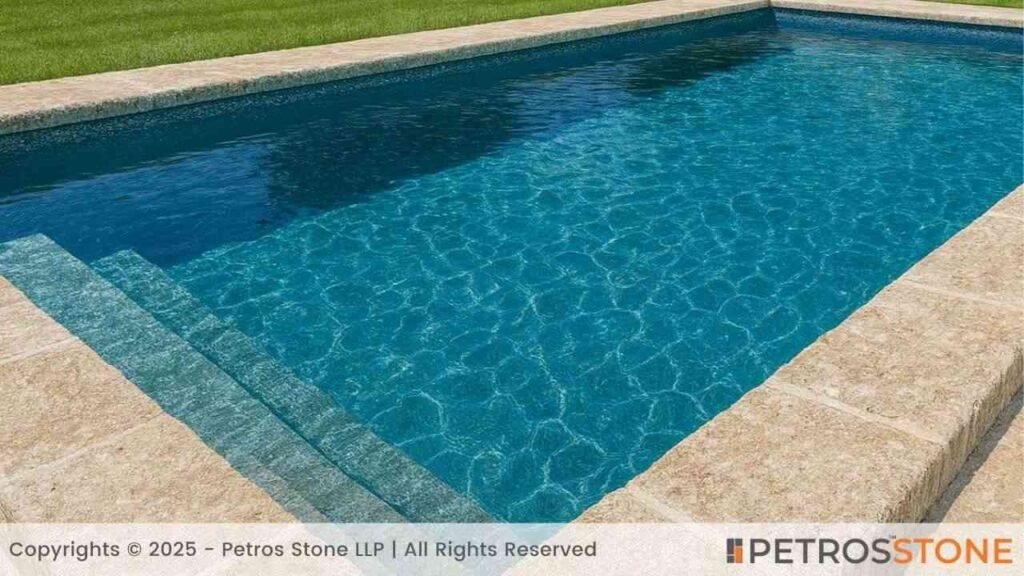
- Appearance: Aged finish with rounded edges.
- Texture: Rough, non-slippery.
- Best Suited: Mediterranean or natural pools.
- Benefits: Very safe in wet applications.
3. Chiseled
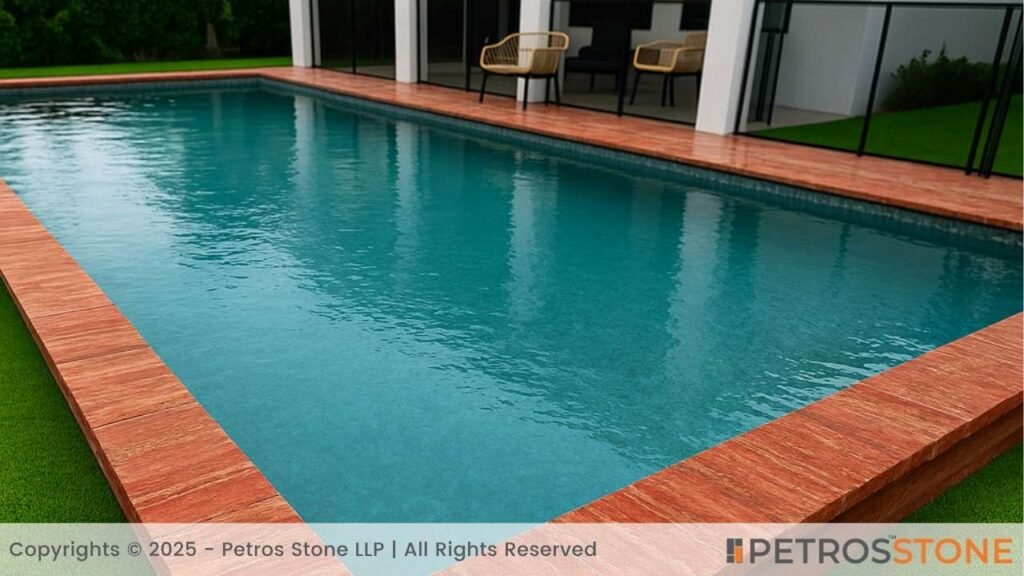
- Appearance: Rocky, coarse style.
- Texture: Sharp surface.
- Best Suited: Natural backgrounds consisting of rock elements.
- Downside: slightly abrasive on feet, but very secure.
4. Slip Resistance Rating of Pool Copings (Out of 2)
| Finish | Texture Level | Slip Resistance (0–2) | Comments |
| Brushed | Light Texture | 1.5 | Good grip; comfortable |
| Tumbled | Strong Texture | 1.8 | Excellent for barefoot areas |
| Chiseled | Very Rough | 2.0 | Max grip; best for safety |
Water Absorption Comparison

How Porous Is Marble?
- Absorption rate: 0.2% to 0.5% by weight, which is low in natural stone.
- Marble becomes watertight and won’t grow mould or algae with sealing.
- Maintenance: should be resealed annually or every 2 years; when neglected, stains may develop, particularly within the powder or shaded regions.
How Porous Is Travertine?
- Absorption rate: d. ~2 to 5 percent weight–greater than that of marble.
- Natural pits trap water and organic matter.
- Uses high-quality sealant annually; filled pit versions minimise maintenance.
Impact on Longevity and Mold Growth
- Marble: Low porosity makes it less prone to mould. Sealed marble is easy to keep clean through normal maintenance, but unsealed surfaces with water edges can pick up algae in the long term.
- Travertine: Extremely porous and has pits which retain moisture and dirt. Mould and algae are relatively easy to form without sealing properly. They must be sealed regularly.
| Material | Absorption Rate | Maintenance Need | Risk of Mold/Algae |
| Marble | 0.2–0.5% | Moderate – refinish 1–2 yrs | Low when sealed properly |
| Travertine | 2–5% | High–seal annually | Higher if pits untreated |
Heat Absorption on Sunny Days
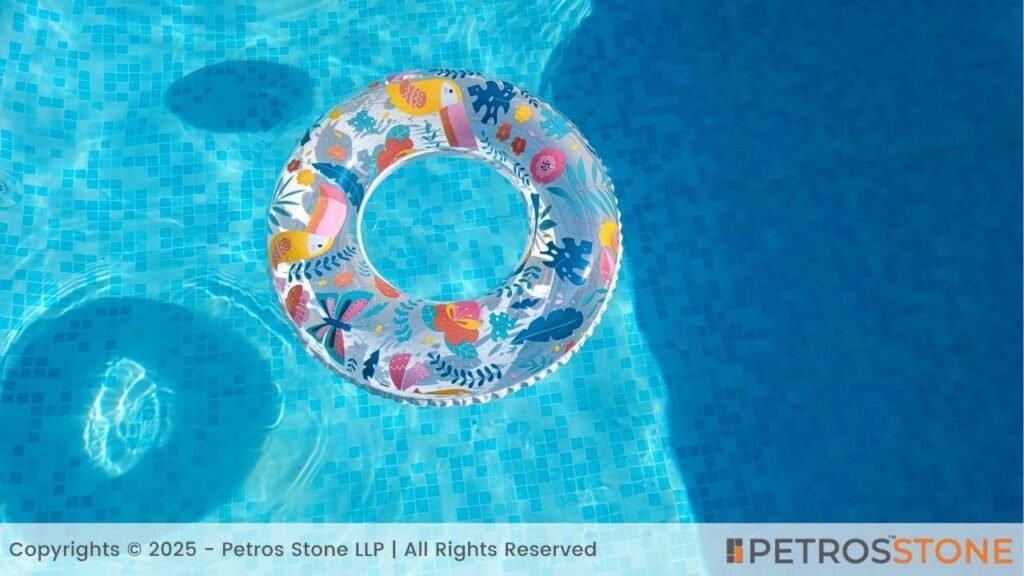
How Hot Does Marble Get?
- Much solar radiation is reflected by light and dense marble.
- On a sunny day during the warm season, the surface temperature can go up to 100–120°F (38–49 °C).
- Polished marble is more reflective and hotter to walk on, honed/tumbled slightly absorbs more heat.
How Hot Does Travertine Get?
- Under direct sunlight, surface temperatures stay between 95 and 115°F (35 and 46 °C).
- Compared to marble, brushed or tumbled finishes are more pleasant and cool.
- The brushed or tumbled finishes are cool and more comfortable as compared to marble.
Comfort Underfoot in Summer
- Travertine: Rough, cooler texture is adaptable to a hot environment.
- Marble: Can be hot or slippery on sore feet when polished. A refined finish enhances grip, although heat may occasionally be felt.
Design Ideas and Aesthetic Appeal
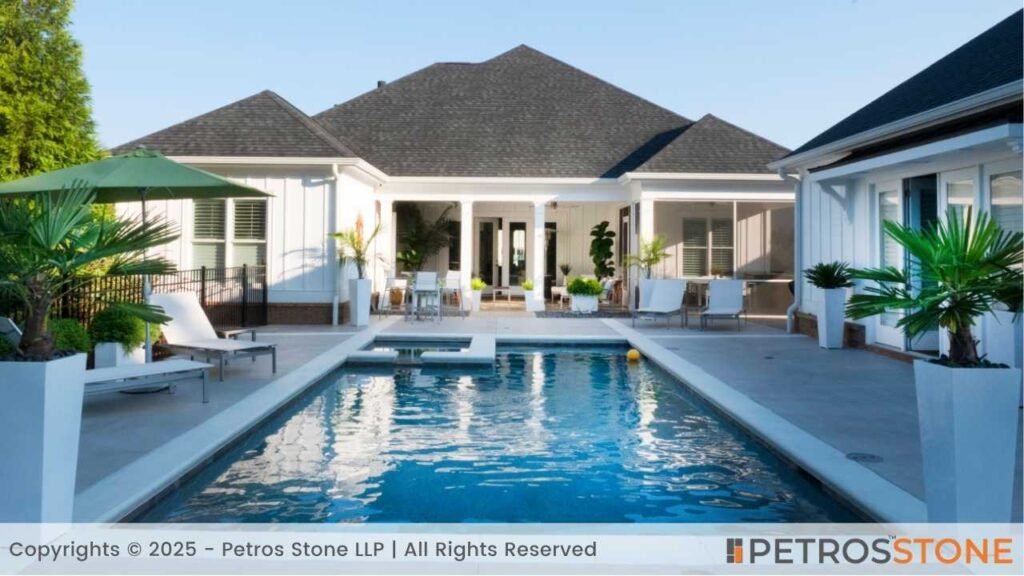
1. Design Flexibility with Marble
- Colours: white, cream, beige, grey, pink, even green or blue.
- Creates both ancient (Roman, Grecian) and modern (sleek, minimalist) swimming pools.
- Easily cut into curved coping shapes, bevels, sharp-edge profiles, and bullnose.
- Complements polished porcelain, glass tile, mosaic, metal finishes, water, and LED lights.
2. Travertine Design Inspirations
- Common colours: ivory, walnut, and russet, and champagne -warm, earthen colourings.
- Rustic, Mediterranean, Tuscan, coastal, temple-type suits.
- Typical elements are waterfall edges, rockwork combinations, boulder accents, and stone column trims.
- Blends perfectly with natural wood decks, gravel edging, flagstone patios, and landscape plants.
3. Pool Styles That Suit Each Material
- Modern Rectangular Pools: Marble presents clean lines, colours and streamlined design.
- Curved or Rock‑Edged Pools: The rugged faces of travertine blend organic rock and plantings.
- Geometric Pools Spine-Tile: Marble underlines the straight edges; travertine sourced the transition.
- Infinity and Water-Feature Pools: Marble can enhance the elegance levels; travertine can provide the warmth found in resorts.
4. Matching Coping with Decking and Tiles
- With Marble: Select smooth decking finishes such as porcelain or high-grade pavers. Neutral tones for sleek coherence.
- With Travertine: Use with faded wooden decks, tinted concrete, pebble or porous stone floors.
- Earthen shades look amazing in greenery, tropical planting, gravel, and outdoor lounge areas.
Which One Is Better for Your Pool?
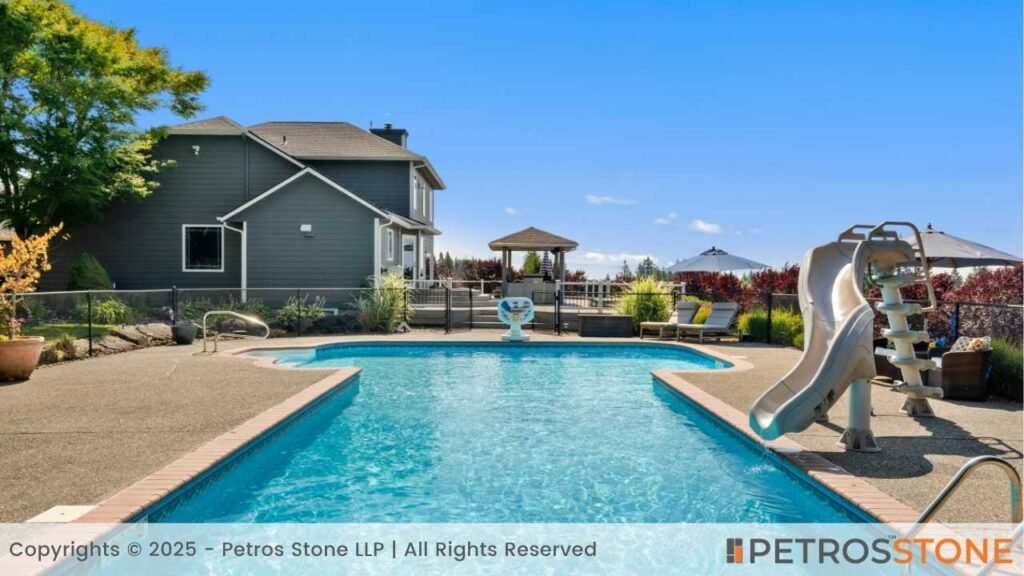
Climate and Regional Considerations
Hot & Sunny
- High UV, heat, and dust favour cooler and safer surfaces.
- Travertine is perfect- low heat retention and natural feel.
Temperate or Humid Areas
- Marble is not prone to mould with sealing.
- In wet climates, travertine requires a sealant at higher intervals.
Cold Climates with Freeze/Thaw
- Both should be frost-rated, with no effect on freeze cycles when sealed.
- Travertine can potentially chip at the edges; marble can crack along veins.
- In this case maybe granite pool coping will be a better option
Safety and Maintenance Priorities
- Safety first? Textured travertine has enhanced slip resistance.
- You do not prefer heavy maintenance? Sealed marble works well, but it remains slippery unless treated.
Visual Appeal vs Functionality
- Want a high-end, sleek look and a budget that allows? Choose honed or safari-style marble.
- Prefer comfort, rustic charm, and lifelike warmth? Travertine has your back.
Our Final Verdict
- Travertine: The all-purpose winner–cool, grippy, economical, low-slug routine. Suits best in hot outdoor situations and barefoot family members.
- Marble: Superior in terms of prestige and formal gardens- most appropriate to diligent, maintenance-oriented owners who prefer a clean, polished look. Select honed or tumbled to provide safety.
- Middle ground: Think honed or lightly tumbled marble to blend slip resistance with an old-school appearance.
Why Compare Marble and Travertine?
Marble and travertine are popular natural stones for pool coping, offering distinct textures. Natural stones are also favoured for pool coping, with marble and travertine the most common (though more textures and finishes and cost profiles are available). This comparison can assist homeowners, designers and other builders to determine which provides optimal value and performance in their climate, budget and safety requirements and design intentions.
This is why this comparison will be useful:
- They are both long-lasting and stunning.
- They vary in terms of slip resistance, tolerance to heat, porosity, and maintenance.
- Their up-front costs and characteristic investments are different.
- Each suite is complementary to various types of landscaping and architecture.
Conclusion
Summary of Key Differences
- Cost: Marble > Travertine.
- Slip-resistance: Travertine > Marble.
- Heat: Travertine remains cooler.
- Porosity: Travertine requires additional sealing.
- Appearance: Marble = luxury; Travertine = natural elegance.
Which One Should You Choose?
- Choose Travertine if your priorities are:
- Safe bare-foot and low heat comfort
- Budget-savvy decision
- Resort appearance, natural look
- Family-friendly walkability
- Choose Marble if you want:
- Elegant, polished sophistication
- Architectural statement
- Reduced porosity and maintenance tolerance
- Readiness to use anti-slip finishes
Feel free to get in touch for a free consultation, quote, and get a detailed understanding from our experts here at Petros®. Visit https://petrosstone.com/ or call +91-8446360361 and WhatsApp

Hello!
I’m Dr Mridali, a content writer with a background in dentistry and a passion for turning complex topics into clear, engaging stories. From healthcare to architecture, I create blogs that inform, educate, and connect with readers. With every piece, I aim to blend accuracy with creativity to make information truly valuable.
Brown Granite
White Galaxy Granite
Blue Bahia Granite
Silver Cloud Granite
Black Pearl Granite
Dallas White Granite


